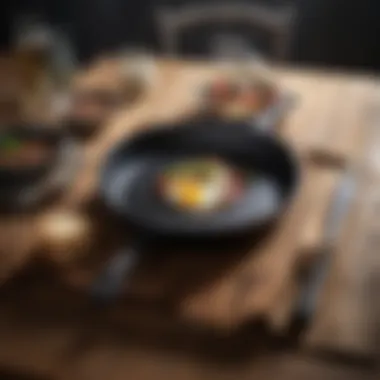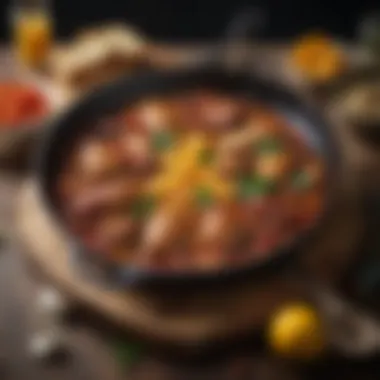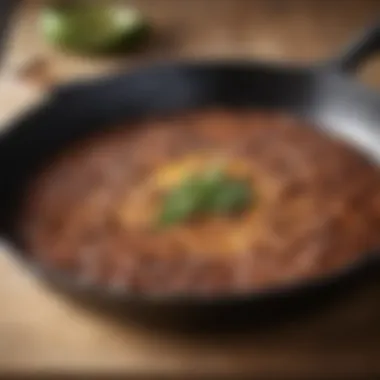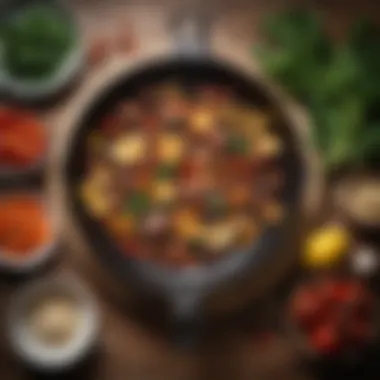Discover the Multifunctionality of Ikea's Cast Iron Skillet


Intro
The Ikea cast iron skillet has made quite a name for itself among culinary enthusiasts. Known for its durability and even heat distribution, this skillet goes beyond being just a common kitchen item. It serves as a beacon for those who appreciate the art of cooking. Whether you're a beginner eager to experiment or an experienced chef looking to elevate your culinary creations, this tool can adapt to your various cooking styles.
The beauty of this skillet is not only in its ability to handle a variety of cooking techniques, but also in the robust flavors it can help create. From searing meats to baking cornbread, the potential uses are practically endless. This guide aims to zero in on the nuances of the Ikea cast iron skillet, including essential maintenance tips and innovative techniques designed to enhance the cooking experience.
By exploring the versatility of this skillet, we will address how its features can complement a range of dishes, spanning different cuisines and levels of complexity. The journey begins here; let's delve into the multifaceted world of the Ikea cast iron skillet.
Prolusion to Cast Iron Cookware
Cast iron cookware holds a distinctive place in the hearts and homes of both seasoned chefs and everyday cooks. This oft-overlooked kitchen staple is more than just a tool; it represents a culinary heritage that has withstood the tests of time and trend. Whether you are simmering a hearty stew or searing a steak, the unique properties of cast iron enhance cooking experiences in countless ways.
With the rise of modern cookware options, one might wonder why cast iron persists. Well, aside from its charming rustic appearance, cast iron is celebrated for its outstanding heat retention and distribution. Unlike other materials, it can go from stovetop to oven seamlessly—a feature that enlivens many one-pot dishes, allowing flavors to meld beautifully. It isn't just about functionality; the weight and feel of cast iron remains unmatched by lighter alternatives, providing a sense of solidity that many users appreciate.
Additionally, many chefs vouch for the way cast iron can naturally improve over time through seasoning, making it not only a purchase but an investment. Maintaining a cast iron piece can lead to a beautifully seasoned, non-stick surface that only gets better with use. In this article, we’ll cast the spotlight on the Ikea cast iron skillet. We will explore its features, advantages, culinary applications, maintenance, and more.
Understanding the significance of this cookware offers insights into why it has remained a beloved choice across cultures and generations.
Historical Context of Cast Iron Skillets
The use of cast iron for cooking is steeped in history, dating back centuries. Early cast iron pots and pans originated in China during the Han Dynasty around 2000 years ago. The practice then spread throughout Europe, where kitchenware began to transform the culinary landscape. In fact, during the 18th century, cast iron skillets became staples in colonial American kitchens, prized for their durability and ability to retain heat.
In those times, these skillets were often artisan-made, about as far removed from mass production as you can get. This touch of history lends a rich narrative to the modern experience with cast iron. Since then, many brands, including Ikea, have embraced the craftsmanship involved in creating cookware that has historical significance while still appealing to today's functional norms.
Researching the evolution of cast iron aligns us with culinary traditions and reminds us of the time-honored techniques that shaped modern cooking. With increasing interest in heritage grain cooking and local food movements, it's clear that the cast iron skillet is far from obsolete. Understanding the roots of this cookware can enhance our appreciation for its role in contemporary cuisine.
Advantages of Cast Iron Over Other Materials
When one kicks off a conversation about cookware, it’s easy to find many advocates for various materials—stainless steel, non-stick, aluminum, and so on. However, cast iron showcases specific advantages that can elevate cooking.
- Heat Retention and Distribution:
Cast iron skillets, once heated, tend to remain at a constant temperature, making them optimal for searing meats or frying. Unlike inferior materials that may cool down too quickly, a cast iron skillet maintains the heat, ensuring a well-cooked dish. - Versatility:
A cast iron skillet is your true kitchen MVP. You can use it for frying, baking, sautéing, and even roasting. Whether you are preparing a cornbread or a grilled cheese sandwich, the skillet handles it all with aplomb. - Natural Non-Stick Surface:
While a well-seasoned cast iron skillet may not have the same feel as traditional non-stick options, it creates a natural non-stick barrier over time. With regular seasoning, it can offer similar results without the potential chemicals found in some modern alternatives. - Durability:
If treated well, cast iron can last a lifetime—or even multiple lifetimes. A good quality skillet can be an heirloom item, passed down through generations, carrying stories and flavors along with it. - Health Benefits:
Cooking with cast iron can also fortify your food with iron. While this is generally a minor enhancement, it can be beneficial, especially for those with iron deficiencies.
In summary, the myriad advantages of cast iron skillets mark them as a versatile and wise choice for cooks seeking quality performance in their culinary endeavors. With Ikea’s commitment to bringing such durable cookware within reach, it’s surely a spotlight worth shining on.
Overview of the Ikea Cast Iron Skillet
In the realm of cookware, the Ikea cast iron skillet has made a name for itself, carving a niche that is hard to overlook. Known for its resilience and remarkable heat retention, this skillet is a culinary companion that elevates both amateur chefs and seasoned cooks alike. By diving deep into the benefits and features of this skillet, we can appreciate its role as not just a tool, but an essential element in the kitchen.
Key Features and Specifications
The Ikea cast iron skillet boasts several attributes that set it apart from alternatives. First off, it is constructed from high-quality cast iron—a material praised for its ability to distribute heat evenly. This means that you can expect consistent cooking results whether you're searing meat or sautéing vegetables. The surface, when properly seasoned, develops a natural non-stick quality, which is not only practical but also enhances the flavor of the food being prepared.
A notable feature is the ergonomic handle, which is designed for a comfortable grip, crucial when maneuvering a hot skillet. There’s a convenient helper handle, too, which provides extra support when pouring out excess oil or transferring food.
Specifications wise, the skillet generally comes in a standard diameter of 10.2 inches (26 cm), which strikes a balance between compact cooking and generous surface area. Weighing around 5.5 pounds (2.5 kg), it provides heft that contributes to its cooking performance.
Additionally, it’s oven-safe, allowing users the versatility to shift from stovetop to oven seamlessly. Some users appreciate that it's ready for direct use. All these attributes culminate in a spectacular cooking experience, making it well worth considering for your kitchen.


Comparing Sizes and Styles Offered by Ikea
Ikea doesn't just offer a one-size-fits-all skillet; rather, it presents a range of sizes and styles to meet various culinary needs. For example, the 10.2-inch version is perfect for smaller meals or side dishes, while a larger 12-inch option is more suited for family-size servings or entertaining guests. Choosing the right size can significantly impact your cooking efficiency and experience.
In terms of styles, Ikea tends to stick to a minimalist design ethos—think clean lines and straightforward functionality. However, their cast iron skillets are often available in various colors, adding a dash of personality to your kitchen décor. While the traditional black remains the classic choice, vibrant colors can make the skillet a statement piece, encouraging creativity in the kitchen.
Moreover, there’s often an emphasis on simplicity in maintenance. Different styles might offer slightly varied finishes, yet the core benefits of durability and heat retention remain constant. From skillets suitable for rustic charm to those designed for modern aesthetics, Ikea’s offerings facilitate personal expression while still being remarkably practical.
Cooking with an Ikea cast iron skillet doesn’t merely begin with the act; it’s an engaging journey that enhances every culinary endeavor, brushing up textures and flavors to create memorable experiences.
Culinary Applications of the Ikea Cast Iron Skillet
The Ikea cast iron skillet's versatility shines brightly when examining its culinary applications. This kitchen staple don’t just serve one function; rather, it’s like a sturdy Swiss Army knife nestled in your cabinet, prepared for numerous cooking adventures. Recognizing how to effectively use this skillet expands its value significantly.
Whether you're a home cook or a seasoned chef, tapping into the skillet's capabilities can elevate everyday meals. Here, we’ll explore essential cooking techniques that truly bring out the best in this beloved cooking tool.
Searing and Sautéing: Techniques and Tips
When it comes to searing, a cast iron skillet is unmatched. Its ability to retain and evenly distribute heat makes it the darling of meat lovers. Imagine a perfectly seared steak—crusty on the outside, juicy on the inside. To achieve this culinary heaven, start by preheating the skillet over medium-high heat for a good five minutes. To test if it’s hot enough, sprinkle a few drops of water onto the surface; they should sizzle and evaporate instantly.
Techniques for Searing:
- Pat Dry: Always pat the meat dry with paper towels before seasoning. This helps to form that coveted crust.
- Minimal Movement: Once the protein is placed in the skillet, resist the urge to poke and prod. Leave it be until you’re ready to flip.
Tips for Sautéing:
- Choose the Right Oil: Use oils with high smoke points like canola or avocado oil. You deal with high temperatures, and we don’t want your oil burning.
- Add Aromatics Last: For a flavorful boost, add garlic and herbs towards the end of your sautéing to avoid burning them.
Keeping these secrets in mind will undoubtedly make your sears and sautés shine.
Baking in a Cast Iron Skillet
Baking might seem peculiar for a skillet, but the cast iron excels in the oven just as much as on the stovetop. From crisp cornbreads to savory frittatas, this tool invites a world of possibilities.
One appealing aspect is how quickly it moves from one element to another. You can easily start cooking something on the stovetop and then slide it into the oven. A perfect example would be a skillet cookie. You can prepare the dough and bake it directly in the skillet for a gooey treat that radiates charm.
Essential Tips for Baking:
- Preheat the Skillet: Just as with searing, preheating your skillet enhances your baked goods’ texture and flavor.
- Use Parchment Paper: For sweet baked goods, lining the skillet with parchment paper makes clean-up a breeze and prevents sticking.
How to Use it for One-Pan Meals
In today’s busy world, the one-pan meal trend is a lifesaver. The Ikea cast iron skillet allows you to combine ingredients and cook in a single vessel, making it an angel for minimalists and busy cooks alike.
Picture this: you toss diced chicken, colorful veggies, and your favorite seasonings into the skillet, all while letting it work its magic. Not only does this method simplify cooking, but it also intensifies flavor as everything melds together.
Creating One-Pan Wonders:


- Layer Wisely: Place tougher ingredients like potatoes on the bottom to cook them perfectly. Softer veggies can go on top to steam as they absorb flavor.
- Finish with Cheese: A sprinkle of cheese at the end of cooking melts beautifully and turns a humble meal into an indulgent plate.
One-pan meals are perfect for a cozy weeknight dinner, packing flavor while saving on cleanup.
Maintaining and Caring for Your Cast Iron Skillet
Taking care of your cast iron skillet is like looking after a prized possession. Proper maintenance can significantly extend its life, ensuring that it serves you faithfully for years. A well-cared-for skillet not only cooks your food beautifully but also becomes better with every use, developing a natural non-stick surface with proper seasoning. Hence, giving attention to maintenance is key.
Seasoning: What It Is and Why It's Important
Seasoning is the process of treating your cast iron with oil, creating a protective layer on the skillet's surface. This layer helps to prevent rust and provides that crucial non-stick capability. You might wonder, why the fuss over seasoning? Well, think of it this way: a well-seasoned skillet can cook your food evenly and retain flavors without those uninvited metallic tastes.
To season your skillet, follow these simple steps:
- Clean the skillet thoroughly; remove any food residue or rust.
- Apply a thin layer of vegetable oil (or another high-smoke point oil) inside and outside the skillet.
- Bake it upside down in an oven preheated to 350°F (175°C) for about an hour. Placing a sheet of aluminum foil below it can catch any drips.
- Let it cool in the oven before taking it out.
A little bit of oil goes a long way, so make sure it's just a thin coat—drying it at high temperatures helps create that solid, slick seasoning.
Cleaning Techniques to Preserve Longevity
A cast iron skillet requires a different touch compared to other cookware. They aren't meant to be soaked in water. The best way is to clean it while it's still warm, using a spatula to scrape away stuck bits of food. Here are a few techniques to keep it in tip-top shape:
- Use a mild detergent sparingly. Contrary to popular belief, a tiny bit of soap won't strip away the seasoning when used carefully.
- Hot water and a stiff brush work wonders. Scrub gently to ensure you don't damage the surface.
- For stubborn residues, sprinkle some coarse kosher salt on the skillet and scrub with a damp cloth or sponge. It acts like an abrasive, helping to lift off those pesky bits.
Remember to dry the skillet immediately after cleaning. Water left behind may lead to unwanted rust.
Storing Your Skillet Properly
Storage is another aspect often overlooked. A little bit of care can go a long way in keeping your skillet functional. First off, do not stack other pans on top of it. If you must, put a cloth in between to avoid scratches.
- Keep it in a cool, dry place. Moisture is the enemy. In damp environments, your skillet can start rusting even with proper seasoning.
- Add a light coat of oil on the surface before storing. This can help shield it from air moisture.
Proper maintenance means fewer headaches down the road. Treat your skillet well, and it will reward you with scrumptious dishes for decades to come!
By following these maintenance practices, you not only prolong the life of the Ikea cast iron skillet but also enhance the cooking experience it provides. In the world of culinary adventures, ensuring your tools are ready is just as vital as the ingredients you choose.
Health and Nutrition Aspects
When it comes to cooking tools, the Ikea cast iron skillet boasts far more than just durability and versatility. Understanding the health and nutrition aspects of this skillet is crucial for anyone who enjoys cooking. With its iron construction, this skillet has unique benefits and some common misconceptions that need addressing. In an era where diet and health take center stage, being informed helps you make the right choices in your kitchen. Cooking with cast iron not only enhances flavor but can also contribute positively to your health if you grasp its intricacies.
Iron Leaching: Myths and Facts
Iron leaching from cast iron skillets is both a topic of concern and fascination. Many people hear about the possibility of iron leaching into food and automatically assume it's a bad thing. However, iron is an essential nutrient for the body that supports numerous vital functions, such as oxygen transport and energy metabolism.
- Myths
- Facts
- All food cooked in cast iron absorbs too much iron: This is false.
- Only acidic foods cause high leaching: Acidic foods can increase iron absorption, but many foods, like vegetables and proteins, can also release iron without compromising safety.


- Cooking in cast iron can increase your iron intake, especially for those who may be iron-deficient.
- This leaching does not pose a threat to health; rather, it can be quite beneficial for many.
Comparative Analysis of Cooking Methods
Exploring how cooking methods differ when using the Ikea cast iron skillet reveals insights into maximizing its utility in the kitchen. Unlike non-stick pans or other materials, cast iron provides a unique cooking experience.
- High heat retention: Cast iron skillets can withstand high temperatures, making them perfect for searing meat and achieving that delectable crust.
- Versatility across cooking techniques: Whether you're sautéing veggies or baking cornbread, the skillet can transition seamlessly from stovetop to oven. Some even swear by using it for slow-cooked meals. Here are a few methods laid out:
- Searing:
- Baking:
- Slow cooking:
- Heat the skillet thoroughly before adding oil.
- Place your protein in the skillet without overcrowding to achieve browning.
- Preheat your skillet for even baking.
- Use it for baked goods like frittatas or even dessert like a skillet brownie.
- Low heat is your friend. Perfect for stews and braises.
- Use the lid appropriately to keep moisture in while cooking slowly.
Using the Ikea cast iron skillet for various cooking methods enhances not only flavor but also nutritional value. When optimizing your culinary practices, understanding these methods ensures you're getting the best out of this remarkable tool.
User Experiences and Testimonials
Understanding how users relate to the Ikea cast iron skillet offers invaluable insights into its real-world performance and practicality in the kitchen. User testimonies often act as a mirror reflecting not only the strengths of the product but also areas where it might not meet some individuals' expectations. This section aims to dissect those experiences, providing prospective buyers with a clear canvas of what they can anticipate when making their purchase.
Real-Life Cooking Scenarios
Real-life cooking scenarios help paint a vivid picture of the versatility offered by the Ikea cast iron skillet. From Sunday brunches to weeknight dinners, users have found innovative ways to integrate this skillet into their culinary routines. Here are a few insightful examples:
- Breakfast Frittatas: Many home cooks rave about the skillet’s ability to produce a beautifully browned frittata. Users have shared that the heat distribution is even, allowing eggs to cook uniformly without sticking, which is often a concern with lesser pans. Adding spinach and cheese becomes not just easy but a delightful experience.
- Sizzling Stir-Fries: A popular feedback point is how well the skillet handles high temperatures, making it ideal for stir-frying vegetables. One user noted that the branding can retain heat much longer than a regular non-stick pan, giving their dishes a great sear and that much sought-after charred flavor.
- Rustic Breads: Some users love using the skillet for baking artisan-style bread. With a lid, it transforms into a bread-baking vessel, delivering crusty rounds that often surprise relatives and friends. The stories of surprise when serving fresh-baked bread from the skillet are always heartwarming to read.
Challenges Faced by Users
While the Ikea cast iron skillet excels in many cooking scenarios, it isn’t without its share of challenges. Users often bring forth several points that are worth noting:
- Initial Weight: A recurring theme among testimonials is the weight of the skillet. Some users mentioned that while the heft contributes to its durability, it can be daunting to handle, especially for those who are not accustomed to cooking with cast iron. This initial adjustment period can be a slight inconvenience.
- Seasoning Difficulties: Another challenge observed is related to the seasoning process. Users have expressed that achieving the desired non-stick surface can take time and effort. Some found it hard to maintain a consistent seasoning layer, leading to occasional sticking.
- Heat Retention and Temperature Management: Several cooks highlighted that while the skillet can get ridiculously hot, managing that heat during cooking can be tricky. One premature mistake users reported was burning their food before quite knowing what happened. It’s essential to understand one’s stovetop settings to avoid this.
"Every journey begins with a single step, and every recipe with a hot skillet. Learning how to navigate that heat changed the way I approach cooking." - A proud Ikea cast iron skillet owner.
In sharing these experiences, both positive and negative, potential buyers gain a holistic view of what makes the Ikea cast iron skillet a valued kitchen tool, as well as some pitfalls to anticipate. This blend of insights not only underscores practical applications but also prepares users for realistic expectations, enhancing their overall journey with cast iron cookware.
End
The journey through the multifaceted features of the Ikea cast iron skillet reveals its significance in both everyday cooking and special culinary endeavors. This skillet is not merely a piece of cookware; it embodies a blend of tradition and modern functionality. For those who embrace culinary creativity, the Ikea cast iron skillet offers a reliable platform that accommodates a variety of cooking styles, from searing a steak to baking a flaky cornbread.
Final Thoughts on the Ikea Cast Iron Skillet
The Ikea cast iron skillet is notable for a handful of reasons. Firstly, its durability sets it apart, capable of withstanding high heat and yet promising longevity with proper care. The ability to enhance flavor through its naturally non-stick surface after seasoning is a boon to cooks who appreciate the nuances of taste.
Also, consider the broad range of recipes you could explore. One might be surprised to learn not just its effectiveness in standard frying, but its versatility extends to baking, braising, and even slow-cooking. Enabling one-pan meals opens up cooking to those who may be time-strapped yet still desire to enjoy scrumptious, home-cooked dishes.
Furthermore, for the health-conscious, concerns about iron leaching, as discussed, illuminate the balance between nourishing your body and enjoying culinary delights.
As users report, the experience of cooking with this skillet is often transformed into an enjoyable ritual, from warmth of preparation to the satisfaction of sitting down with loved ones. The community of users offers a rich tapestry of experiences, highlighting not just successes, but challenges that foster growth in one’s cooking journey.
In short, investing in an Ikea cast iron skillet is stepping into a world where practicality meets tradition, paving the way for both novice and seasoned cooks to explore and express their culinary spirit.







